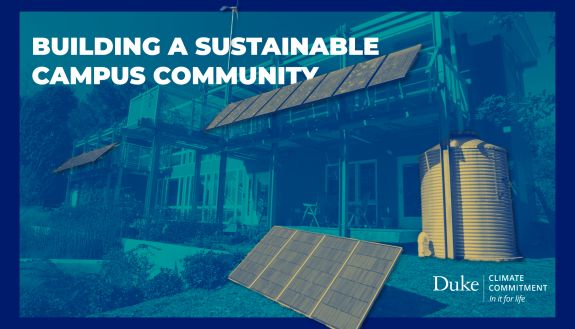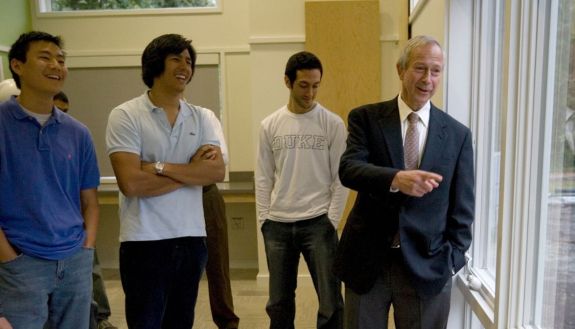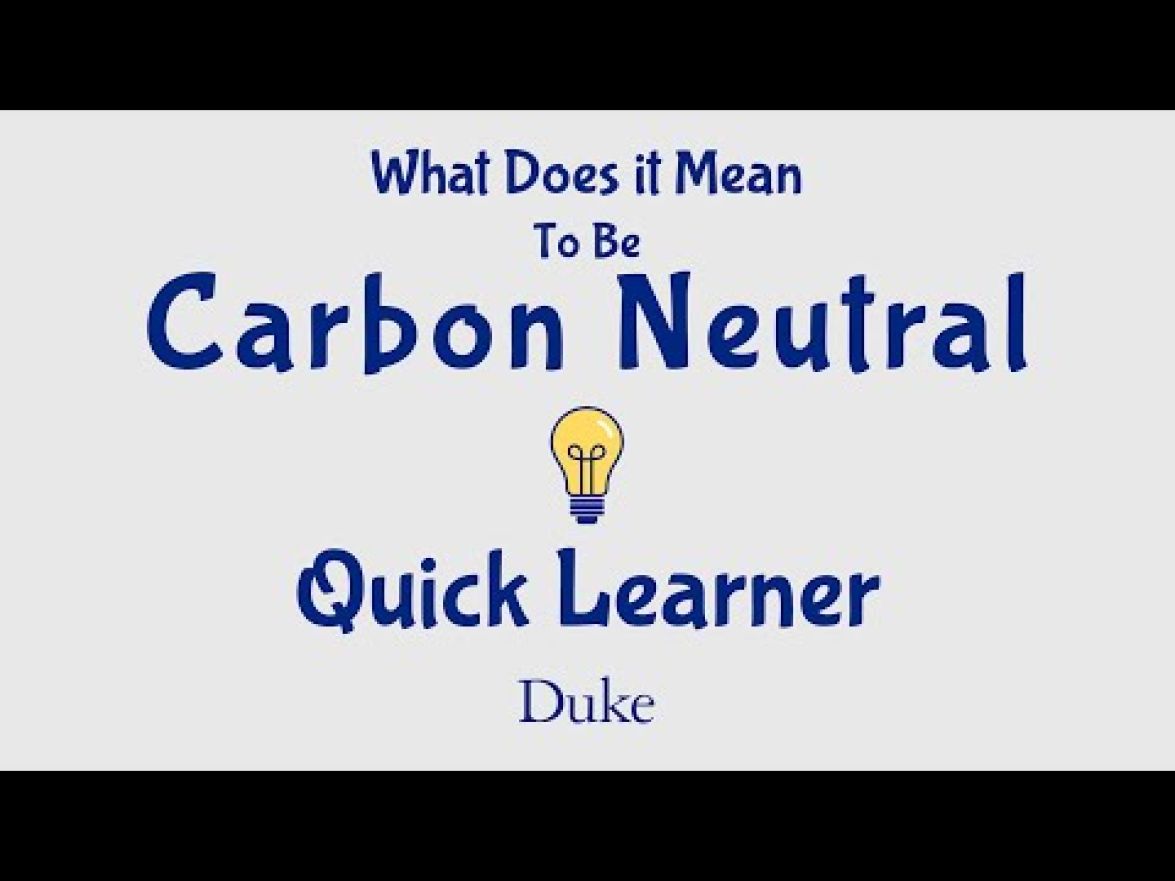
Duke Reaches Important Milestone in Carbon Neutrality
Duke University first among its academic peers to achieve carbon neutrality
To reach this ambitious goal, Duke has invested hundreds of millions of dollars in infrastructure improvements and efficiencies that will pay for themselves over time in reduced energy costs. The entire campus heating and cooling system is being rebuilt while other efficiencies have been wrung out of operations, transportation, and energy use wherever possible. Duke has also invested heavily in high-quality carbon offsets created by activities that capture greenhouse gas emissions.
“This is a remarkable accomplishment and a critical milestone for the Duke community,” said President Vincent E. Price. “I’m grateful to my predecessor Dick Brodhead and Executive Vice President Emeritus Tallman Trask for setting Duke on the path to carbon neutrality, as well as to Tavey Capps for her tremendous work leading Duke’s sustainability efforts since 2006. This is an achievement we can all be proud of, and one that I hope will only strengthen our momentum as we pursue our bold ambitions through the Duke Climate Commitment.”


Duke joins 13 other schools that have declared victory on the 2007 American College & University Presidents' Climate Commitment (ACUPCC), a network of institutions that had committed to make a high-visibility effort to address the global climate crisis. There were 284 university presidents who signed the pledge in June 2007, including Duke's Richard Brodhead; by 2010, that number had swelled to nearly 700.
Carbon Neutrality is Viewed in Three Ways
The World Resources Institute’s Greenhouse Gas Protocol
divides the problem of reaching net zero emissions into three 'scopes,' or areas to be addressed.
Scope 1 is fuel use on campus, for generating steam and hot water in Duke's case, and running the campus fleet of buses, trucks and lawnmowers. This category represented 30% of campus emissions in 2024.
Scope 2 is the energy Duke buys from its electric company, in this case Duke Energy, which shares its namesake, James B. Duke. Next year, Duke University’s 101-megawatt solar installation will come online reducing Scope 2 emissions by nearly half. Scope 2 was 34% of campus emissions in 2024.
Scope 3 are all other emissions that are not in Scope 1 and 2 and represent emissions that come from Duke, but are not fully owned or controlled by Duke. Scope 3 emissions include the fuel that employees consume commuting to work, air travel paid by Duke University, and waste generated by Duke. Scope 3 was the largest source of emissions in 2024, representing roughly 36% of the university's total.
The university is using its carbon offset credits to primarily cover Scope 3 emissions and the remaining energy-related emissions, making Duke the first of its peers to become carbon neutral.
Of those institutions to reach the goal however, Duke is by far the largest in terms of student population and greenhouse gas emissions. The remainder are smaller and more specialized institutions.
“Achieving carbon neutrality on campus is a triple winner — we reduce our carbon footprint, we save money in the long term, and we demonstrate how universities can be part of the climate solution," said Toddi Steelman, Vice President and Vice Provost for Climate and Sustainability.
In mid-2025, Duke's carbon footprint will shrink even more when three off-campus solar energy facilities come online to provide about half of the electricity for campus. This 101-megawatt solar energy project will provide renewable energy to North Carolina’s grid for decades to come. The project was supposed to be completed in time for the carbon neutrality deadline, but ran into supply chain difficulties during the Covid pandemic.
"Full scale mitigation of campus emissions is a long journey, especially for large institutions," said Meredith Leigh, a climate programs manager at Second Nature, a non-profit that focuses on climate action in higher education and coordinates the presidents' pledge. "Duke University represents exemplary leadership among early adopters of the President's Climate Commitment by not only investing in long term reductions of campus emissions, but also in conducting research and detailed in-house vetting of carbon offsets that represent true emissions reduction claims."
Duke was already investing in sustainability efforts when the President's Commitment was created. Not long after Brodhead signed the pledge, he created a standing Campus Sustainability Committee (CSC) composed of faculty, staff, and students. Duke’s Executive Vice President, Tallman Trask III, co-chaired that panel and launched Duke’s first sustainability office, Sustainable Duke, which has grown to become a key part of the Office of Climate and Sustainability.
In 2021, as progress toward the carbon neutrality goal continued, a task force of the Board of Trustees began discussing next steps, which led to the launch of the Duke Climate Commitment in Fall 2022, a campus-wide effort to address the climate challenge through research, education, external engagement, community partnerships and continued improvements in campus operations.
Duke's largest emissions reductions came from activities the university has the most control over: campus electricity use and steam plant emissions. Emissions related to campus energy use have declined by 42 percent from the baseline year, despite the significant growth of campus.
Yet, even with this tremendous progress over the last 17 years, the University knew it could not achieve carbon neutrality without offsets. The University purchases electricity from Duke Energy, which is not carbon neutral, and the university is prohibited from purchasing any additional renewable energy because of North Carolina’s regulated utilities. So, 232,000 of the carbon offset credits Duke has accumulated over more than a decade of research and investment are being redeemed to get to zero.
Offset credits are produced by activities that capture or avoid the creation of new greenhouse gas emissions. Duke has retired offsets from four primary projects to reach the neutrality goal. To ensure these purchases were of the highest-quality, the Office of Climate and Sustainability developed a rigorous evaluation framework and a faculty advisory committee.
Duke officials also stress that achieving carbon neutrality is not the end of the university's climate efforts.
"In many ways, this carbon neutrality achievement is just the beginning of a much larger culture shift and transformation," Steelman said. "Our Duke Climate Commitment extends to every facet of our university – including not just operations, but research, education, community partnerships and external engagement. We want wholesale change.”

Construction continues on a hot water system to replace Duke's distributed steam system that will use up to 30 percent less energy to heat buildings. Building systems are also continually being upgraded with more energy efficient lighting and 'smart building' climate controls.
The hardworking bus fleet that ferries students and employees between East and West campus is steadily being converted to hybrid and electric vehicles. The fleet currently runs nine hybrids and six fully electric buses, with four more electric buses being added in 2025.
But the most difficult portion of Duke's greenhouse gas emissions portfolio is something campus leadership has less control over: business air travel and the workforce’s daily commute. Squaring the ongoing need for a global university's faculty and staff to attend meetings or conduct research around the world with the Climate Commitment is the next challenge for the university.
The COVID pandemic reduced commuting and air travel emissions substantially, dropping commuting emissions 85% and air travel emissions 98% between 2019 and 2021. The post-pandemic reliance on more remote and hybrid work has kept commuting emissions somewhat lower than before, according to Tavey Capps, executive director of climate and sustainability, but air travel is right back where it was.
The university's students have also changed, Capps said. "I think they're coming in with the expectation that this is what universities should do. Students want their campus to reflect their values and are always pushing for additional change. Our renewed and expanded Climate Commitment is also driving a new evolution of this work across Duke."
"Through this work, and its contributions to Second Nature's Climate Leadership Network, Duke has helped pave the way for higher education to accelerate climate action faster and at scale," Second Nature's Leigh said.
Related Stories on Duke Climate Neutrality




